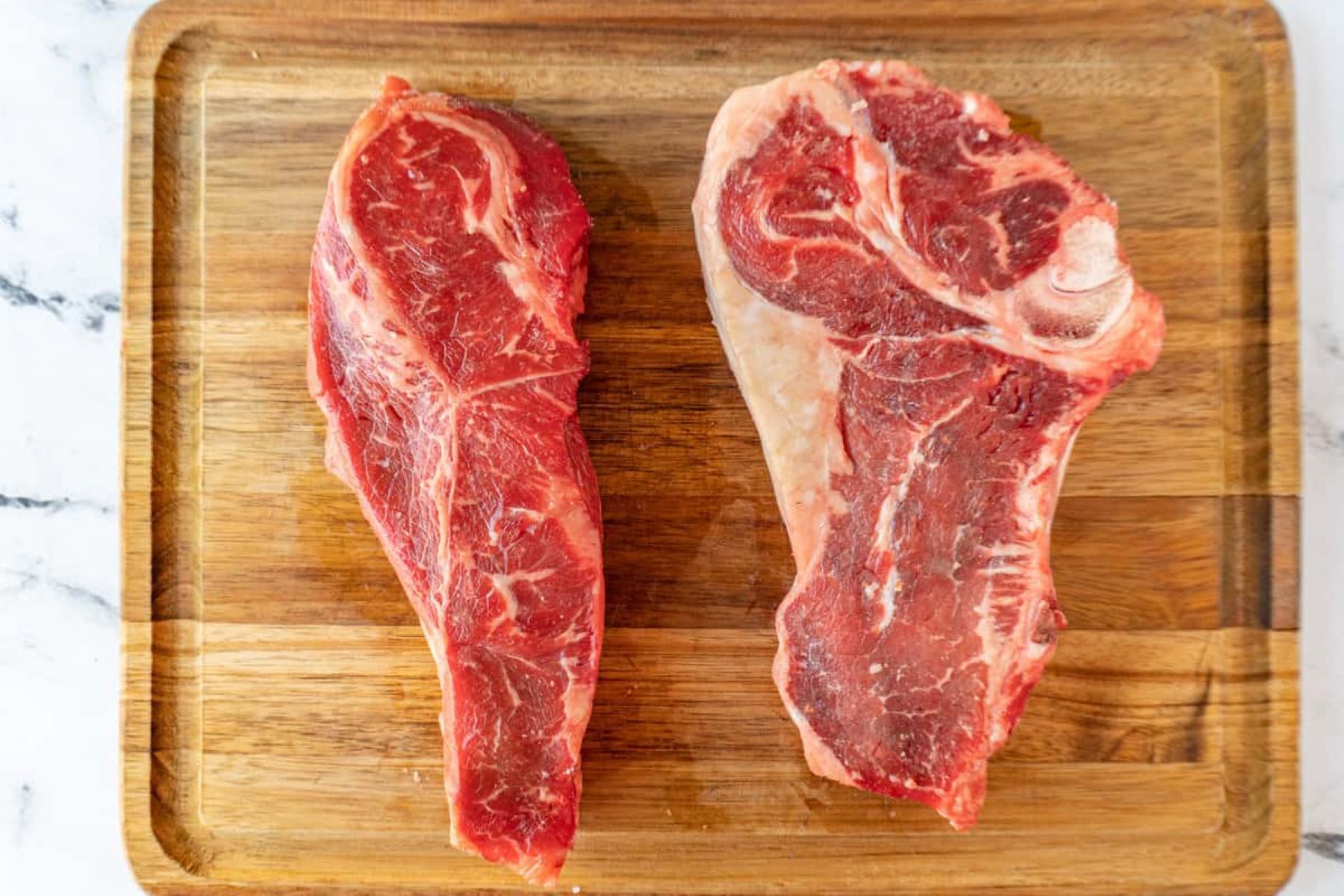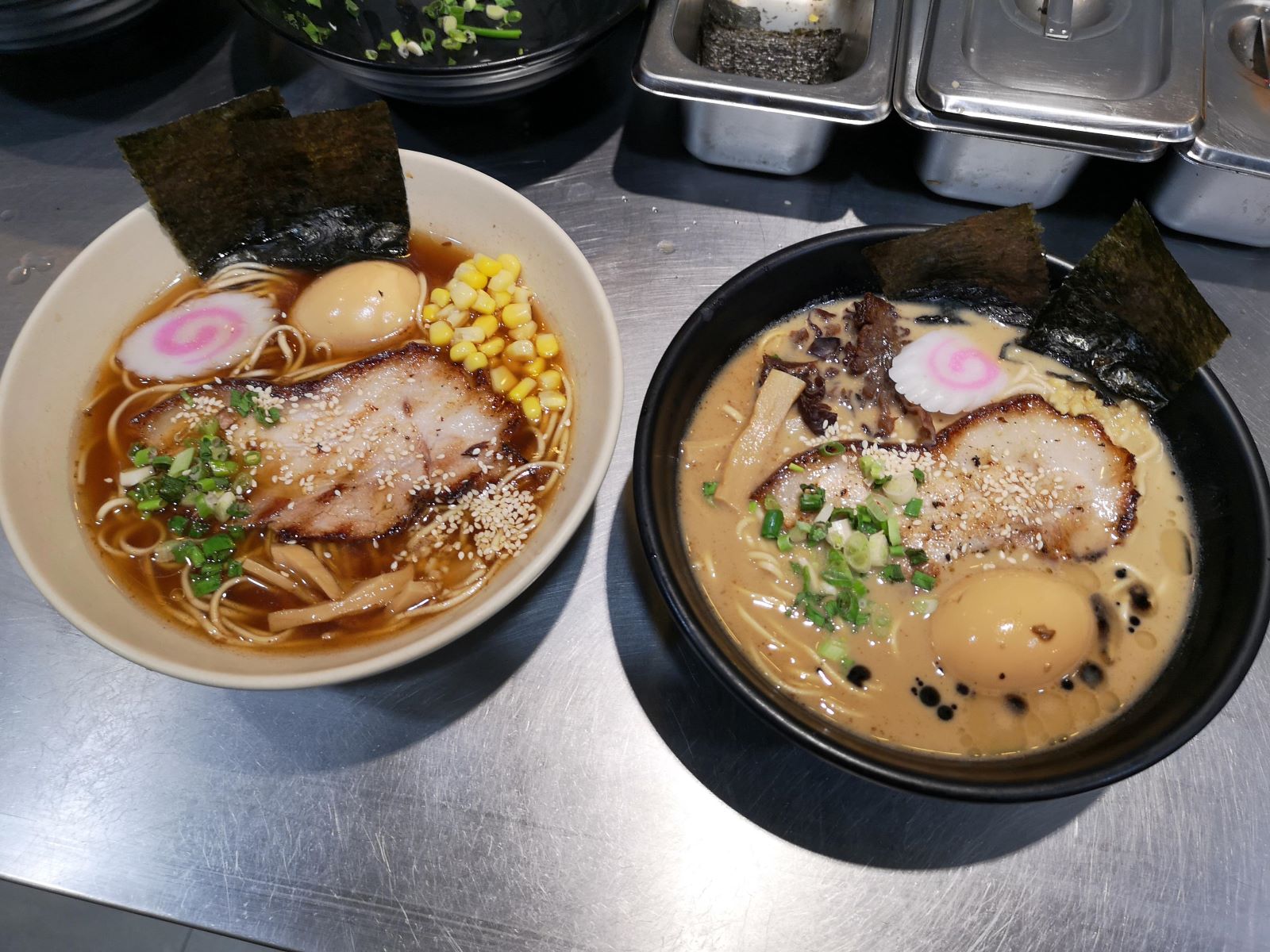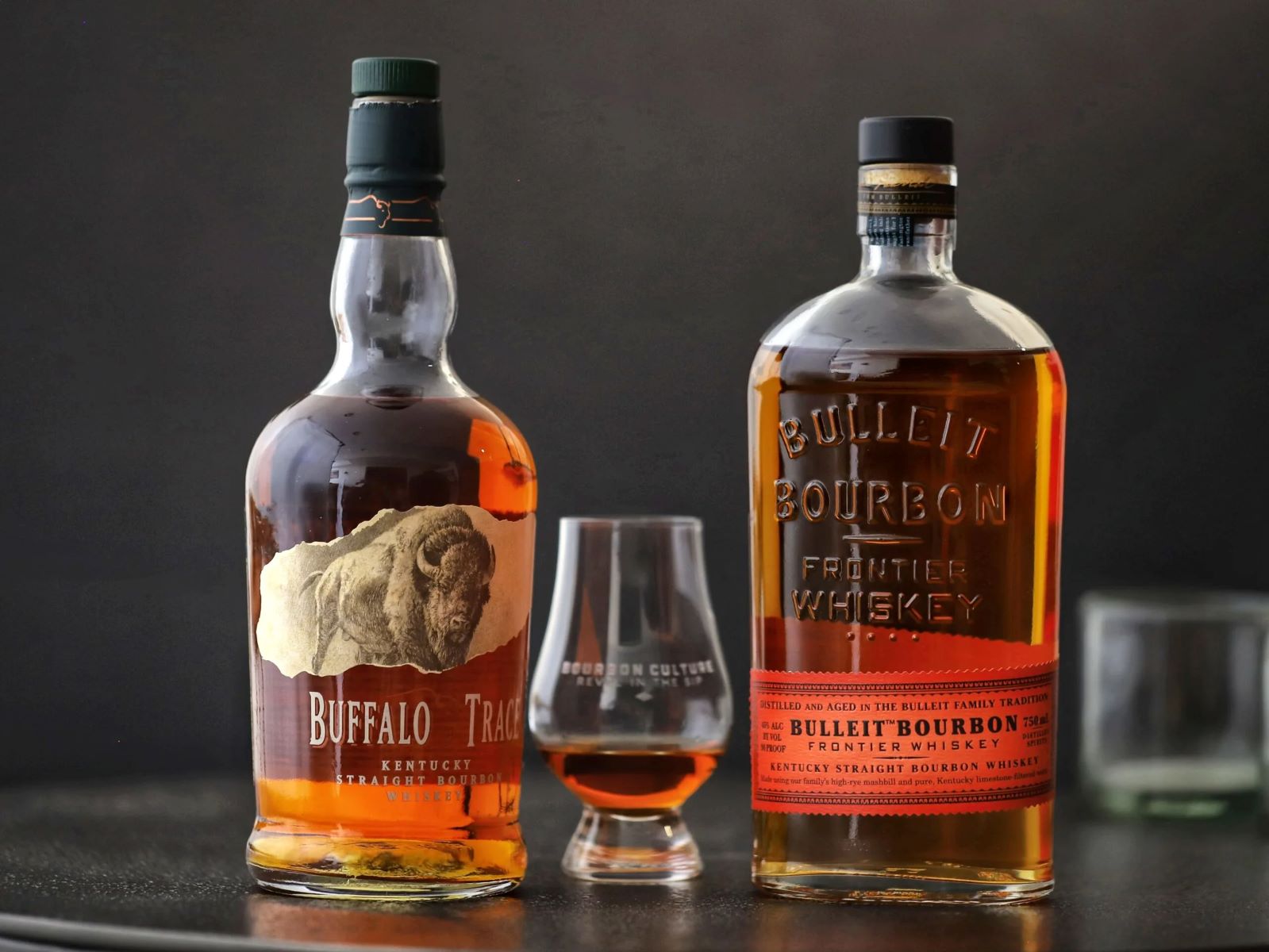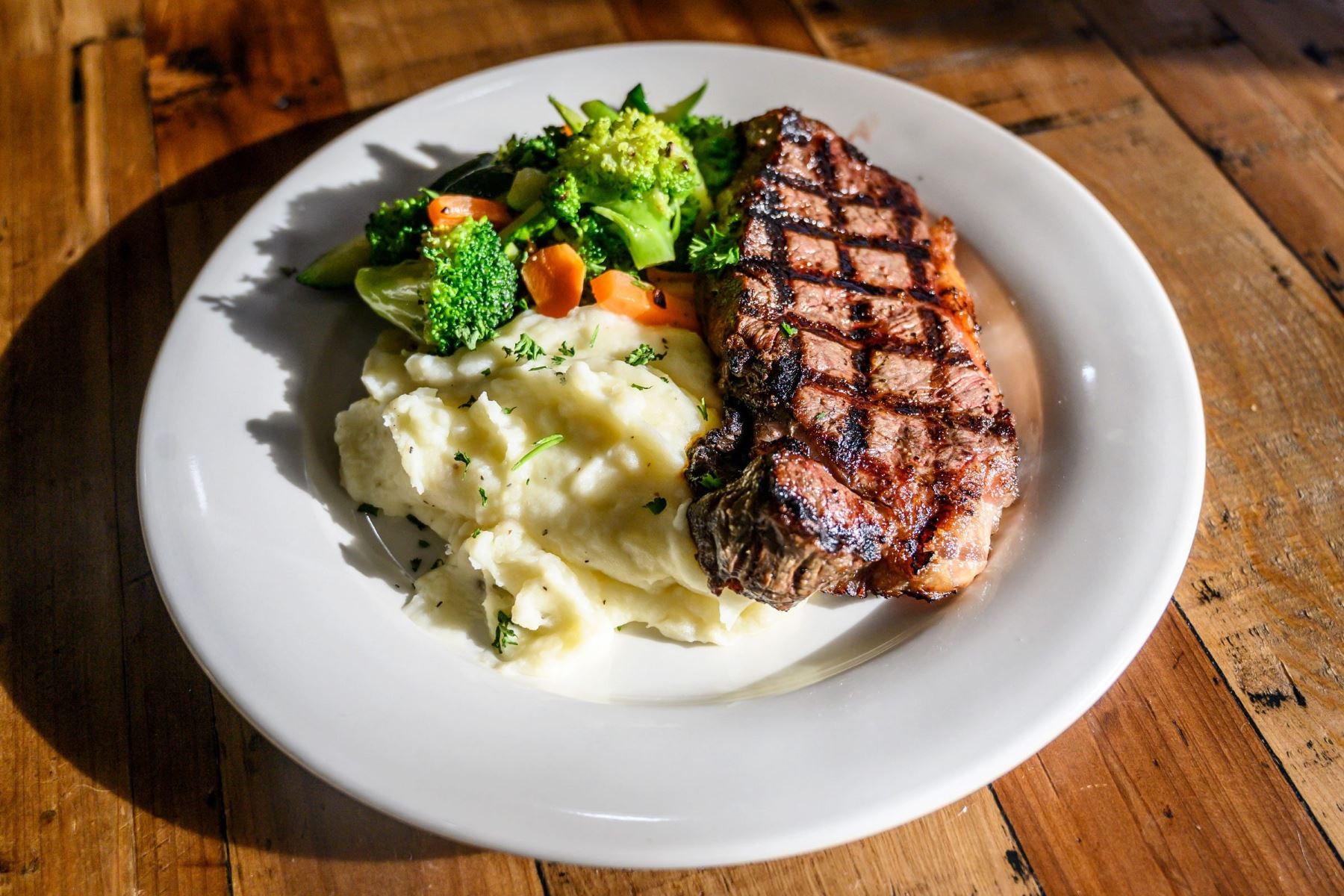Home>Food and Cooking>The Ultimate Steak Showdown: Ribeye Vs Sirloin – Which Reigns Supreme?


Food and Cooking
The Ultimate Steak Showdown: Ribeye Vs Sirloin – Which Reigns Supreme?
Published: February 1, 2024
Discover the ultimate steak showdown between ribeye and sirloin, and find out which cut reigns supreme. Explore the best cooking tips and recipes in the world of food and cooking.
(Many of the links in this article redirect to a specific reviewed product. Your purchase of these products through affiliate links helps to generate commission for Regretless.com, at no extra cost. Learn more)
Table of Contents
Introduction
When it comes to savoring a succulent steak, the debate between ribeye and sirloin aficionados has raged on for generations. Both cuts are renowned for their distinctive flavors, textures, and culinary versatility, making them perennial favorites among steak enthusiasts. Whether you're a devoted carnivore or a culinary connoisseur seeking the ultimate steak experience, understanding the nuances of ribeye and sirloin steaks is essential for making an informed choice. In this comprehensive comparison, we'll delve into the characteristics, flavors, cooking methods, nutritional profiles, and cost considerations of these two revered cuts. By the end of this showdown, you'll be equipped with the knowledge to determine which reigns supreme in the ultimate steak showdown: ribeye or sirloin. So, grab your apron and sharpen your knives as we embark on a flavorful journey into the heart of steak excellence.
What Makes a Ribeye Steak?
A ribeye steak, also known as a Delmonico or Spencer steak, is a prime cut that originates from the front section of the longissimus dorsi muscle, specifically from ribs six through twelve. This positioning near the rib cage imparts the ribeye with exceptional marbling, resulting in a rich and robust flavor profile. The superior marbling, characterized by delicate intramuscular fat, contributes to the steak's tenderness and juiciness, making it a highly sought-after choice among steak enthusiasts.
The hallmark of a ribeye steak is the generous distribution of fat throughout the cut, which not only enhances its flavor but also ensures a moist and tender texture when cooked to perfection. The marbling, consisting of fine streaks of fat intertwined with lean muscle, melts during the cooking process, infusing the meat with a delectable buttery essence and a melt-in-your-mouth sensation that is synonymous with a top-tier steak experience.
Furthermore, the ribeye's distinctiveness lies in its two primary variations: bone-in and boneless. The bone-in ribeye, also referred to as a cowboy or tomahawk steak, features the rib bone, which adds an extra depth of flavor and succulence to the meat during cooking. On the other hand, the boneless ribeye, often favored for its ease of preparation, showcases the full extent of the marbling, allowing for a consistent distribution of flavor and tenderness throughout the entire cut.
In essence, what sets the ribeye steak apart is its exceptional marbling, resulting in a decadent flavor profile and a luxurious, melt-in-your-mouth texture that elevates the steak dining experience to unparalleled heights. Whether seared to perfection on a sizzling grill or expertly pan-seared to a mouthwatering medium-rare, the ribeye's inherent qualities make it a quintessential choice for those seeking a delectable and indulgent steak encounter.
What Makes a Sirloin Steak?
The sirloin steak, a beloved staple in the realm of beef cuts, is renowned for its exceptional balance of flavor and texture. Derived from the sirloin section of the cow, this cut embodies a harmonious combination of tenderness and robust beefy taste. The sirloin is divided into two primary categories: top sirloin and bottom sirloin, each offering distinct attributes that cater to varying culinary preferences.
The top sirloin, situated close to the tenderloin, boasts a remarkable tenderness coupled with a pronounced beefy flavor. Its moderate marbling enhances the steak's juiciness and succulence, making it an enticing choice for discerning steak enthusiasts. The top sirloin's versatility shines through when subjected to various cooking methods, including grilling, broiling, or pan-searing, allowing for a delightful interplay of flavors and textures that elevate the dining experience.
Conversely, the bottom sirloin, also known as the sirloin butt, presents a slightly firmer texture and bolder beef flavor compared to its top sirloin counterpart. While exhibiting less marbling, the bottom sirloin compensates with a robust, meaty essence that lends itself well to marinades and bold seasoning. This cut is often favored for its affordability and suitability for braising, making it an excellent choice for hearty stews and slow-cooked dishes.
The sirloin steak's distinctive characteristics, including its balanced tenderness, robust beef flavor, and versatility in culinary applications, underscore its enduring popularity among steak aficionados and culinary professionals alike. Whether savored as a sizzling grilled masterpiece or incorporated into a sumptuous slow-cooked creation, the sirloin's innate qualities make it a compelling contender in the realm of premium beef cuts.
In essence, the sirloin steak's exceptional attributes, encompassing a harmonious blend of tenderness and robust flavor, position it as a formidable rival to the esteemed ribeye. With its unique qualities and culinary adaptability, the sirloin stands as a compelling choice for those seeking a delectable and satisfying steak encounter.
Flavor Profile
The flavor profile of a ribeye steak is characterized by its luxurious richness and depth, owing to its exceptional marbling and robust beefy essence. The intricate web of delicate intramuscular fat woven throughout the ribeye cut contributes to its unparalleled succulence and intense flavor. As the steak undergoes the cooking process, the marbling melts, infusing the meat with a buttery, melt-in-your-mouth sensation that captivates the palate. This interplay of marbling and lean muscle creates a symphony of flavors, ranging from savory umami notes to subtle hints of nuttiness, culminating in a gratifyingly beefy taste that lingers with each indulgent bite.
In contrast, the sirloin steak boasts a well-rounded flavor profile that strikes a harmonious balance between tenderness and robust beefiness. The top sirloin, with its moderate marbling, exudes a mellow beef flavor accentuated by its inherent tenderness, offering a delightful interplay of juiciness and savory depth. On the other hand, the bottom sirloin, with its bolder beef essence and firmer texture, presents a more assertive flavor profile, ideal for those seeking a hearty, meat-forward experience. Whether grilled to perfection or incorporated into a slow-cooked masterpiece, the sirloin's flavor profile encompasses a spectrum of savory nuances, ranging from robust meatiness to subtle undertones of sweetness, ensuring a gratifying dining experience with every savory bite.
In essence, the ribeye and sirloin steaks each boast a distinct flavor profile that caters to varying palates and culinary preferences. While the ribeye captivates with its opulent marbling and decadent richness, the sirloin entices with its balanced blend of tenderness and robust beefy essence. These flavor profiles, shaped by the unique characteristics of each cut, underscore the enduring allure of these esteemed steaks, offering a tantalizing array of sensory experiences for discerning steak enthusiasts.
Texture and Tenderness
The texture and tenderness of a steak are pivotal factors that significantly influence the overall dining experience. In the realm of premium beef cuts, both ribeye and sirloin steaks boast distinct textural qualities and levels of tenderness, each contributing to the sensory delight of savoring a perfectly prepared steak.
The ribeye steak, renowned for its exceptional marbling, embodies a luxurious texture and unparalleled tenderness that sets it apart as a prime choice for steak enthusiasts. The delicate intramuscular fat distributed throughout the ribeye cut intricately weaves into the lean muscle, resulting in a velvety, melt-in-your-mouth texture that epitomizes steak excellence. As the ribeye undergoes the cooking process, the marbling melts, imparting a luscious, buttery essence that permeates the meat, ensuring a succulent and tender bite with every forkful. Whether seared to a delectable medium-rare or grilled to perfection, the ribeye's inherent tenderness and sumptuous texture elevate the steak dining experience to unprecedented heights, captivating the palate with each indulgent mouthful.
In contrast, the sirloin steak, with its distinctive balance of tenderness and robust beef flavor, offers a diverse textural experience that caters to varying culinary preferences. The top sirloin, characterized by its moderate marbling and inherent tenderness, presents a velvety texture that seamlessly gives way to the rich, savory essence of the meat. The interplay of juiciness and supple texture creates a gratifying sensation with each bite, showcasing the top sirloin's exceptional tenderness and culinary appeal. On the other hand, the bottom sirloin, with its firmer texture and bolder beef flavor, exudes a robust and substantial mouthfeel that resonates with those seeking a more substantial steak encounter. The bottom sirloin's resilient texture, coupled with its pronounced beefy essence, offers a hearty and satisfying dining experience, making it a compelling choice for those with a penchant for robust flavors and substantial textures.
In essence, the ribeye and sirloin steaks each present a distinctive interplay of texture and tenderness, shaped by their inherent qualities and culinary characteristics. While the ribeye captivates with its luxurious, melt-in-your-mouth texture and unparalleled tenderness, the sirloin entices with its diverse textural experiences, ranging from velvety tenderness to robust, substantial mouthfeel. These textural and tenderness attributes, intrinsic to each cut, underscore the enduring appeal of ribeye and sirloin steaks, offering a captivating array of sensory experiences for discerning steak enthusiasts.
Cooking Methods
Cooking methods play a pivotal role in unlocking the full potential of ribeye and sirloin steaks, allowing their distinct qualities to shine through and delight the senses. Whether searing, grilling, or broiling, each cooking technique accentuates the inherent flavors, textures, and tenderness of these esteemed cuts, offering a myriad of culinary experiences for steak enthusiasts.
For ribeye steaks, the preferred cooking methods often revolve around high-heat techniques that harness the steak's exceptional marbling and rich flavor. Searing the ribeye on a sizzling hot grill or in a well-seasoned cast-iron skillet creates a caramelized crust while sealing in the steak's succulent juices. This method enhances the ribeye's buttery texture and amplifies its robust, beefy essence, resulting in a sumptuous dining experience. Additionally, the reverse-sear technique, which involves slow-cooking the ribeye at a low temperature before finishing with a high-heat sear, ensures a uniform doneness and a luxuriously tender texture that is synonymous with premium steak indulgence.
In contrast, the sirloin steak's versatility allows for a spectrum of cooking methods that cater to its balanced tenderness and robust flavor. Grilling the sirloin over an open flame imparts a delightful smokiness while accentuating its savory depth, creating a harmonious interplay of flavors and textures. Broiling the sirloin in the oven ensures a delectably caramelized exterior while preserving the steak's succulence, resulting in a tantalizing contrast of textures and a gratifyingly robust flavor profile. Furthermore, marinating the sirloin prior to grilling or pan-searing infuses the meat with an array of complementary flavors, enhancing its inherent beefy essence and offering a dynamic culinary experience for discerning palates.
Whether opting for the opulent marbling of a ribeye or the balanced tenderness of a sirloin, the choice of cooking method significantly influences the steak's final presentation and sensory appeal. By leveraging high-heat techniques, slow-cooking methods, or flavor-enhancing marinades, both ribeye and sirloin steaks can be transformed into exquisite culinary masterpieces that captivate the palate and elevate the steak dining experience to unparalleled heights.
Nutritional Value
When evaluating the nutritional value of ribeye and sirloin steaks, it's essential to consider the macronutrient composition, micronutrient content, and overall dietary impact of these revered cuts. Both ribeye and sirloin steaks offer a rich array of essential nutrients that contribute to a well-rounded and indulgent dining experience, making them sought-after choices for those seeking a balance of flavor and nutritional benefits.
Macronutrient Composition
Ribeye and sirloin steaks are renowned for their high protein content, making them valuable sources of essential amino acids necessary for muscle repair and overall bodily function. Additionally, these cuts provide a notable amount of high-quality fats, including monounsaturated and saturated fats, which contribute to the richness and succulence of the meat. While ribeye steaks typically exhibit a higher fat content due to their exceptional marbling, sirloin steaks offer a leaner alternative without compromising on flavor, catering to varying dietary preferences and nutritional needs.
Micronutrient Content
In terms of micronutrients, both ribeye and sirloin steaks are excellent sources of essential vitamins and minerals that support overall health and well-being. These cuts are notably rich in B vitamins, including B12, niacin, and B6, which play crucial roles in energy metabolism, neurological function, and red blood cell production. Additionally, ribeye and sirloin steaks provide essential minerals such as iron, zinc, and phosphorus, which contribute to various physiological processes, including oxygen transport, immune function, and bone health.
Dietary Impact
The dietary impact of ribeye and sirloin steaks extends beyond macronutrients and micronutrients, encompassing their role in fulfilling satiety, supporting muscle maintenance, and contributing to a balanced dietary intake. While ribeye steaks, with their higher fat content, offer a decadent and indulgent dining experience, sirloin steaks provide a leaner option that aligns with dietary preferences focused on lower fat intake. Both cuts, when incorporated into a well-rounded diet, offer a valuable source of essential nutrients and contribute to a satisfying and nourishing culinary experience.
In essence, the nutritional value of ribeye and sirloin steaks underscores their role as wholesome and indulgent sources of essential nutrients, offering a balance of high-quality protein, beneficial fats, and vital vitamins and minerals. Whether relishing the opulent richness of a marbled ribeye or savoring the lean tenderness of a sirloin, these esteemed cuts contribute to a diverse and fulfilling dietary landscape, enriching meals with their nutritional prowess and culinary allure.
Cost Comparison
When it comes to selecting the perfect steak, cost considerations play a significant role in shaping the overall dining experience. The cost comparison between ribeye and sirloin steaks encompasses various factors, including market pricing, yield per cut, and culinary versatility, all of which contribute to the perceived value and affordability of these esteemed beef selections.
Ribeye steaks, renowned for their exceptional marbling and luxurious texture, often command a higher price point in the market due to their premium attributes. The intricate marbling that sets ribeye apart contributes to its rich flavor profile and succulent tenderness, making it a coveted choice among steak enthusiasts. However, this superior marbling also impacts the yield per cut, resulting in a slightly lower meat-to-fat ratio compared to leaner cuts such as the sirloin. As a result, the premium nature of ribeye steaks is reflected in their pricing, positioning them as a gourmet indulgence that embodies opulence and culinary extravagance.
On the other hand, sirloin steaks, with their balanced tenderness and robust beef flavor, offer a compelling combination of affordability and culinary versatility. The top sirloin, in particular, presents a favorable yield per cut, providing a generous portion of lean, flavorful meat at a relatively moderate price point. This affordability, coupled with the sirloin's adaptability to various cooking methods, makes it an attractive option for those seeking a satisfying steak experience without compromising on quality or flavor. Additionally, the sirloin's culinary flexibility, ranging from grilling to braising, enhances its overall value proposition, offering a multifaceted culinary canvas that appeals to a diverse audience of steak enthusiasts.
When considering the cost comparison between ribeye and sirloin steaks, it's essential to weigh the premium attributes of ribeye against the balanced affordability and culinary adaptability of sirloin. While ribeye steaks embody luxury and indulgence, sirloin steaks offer a compelling combination of value and versatility, catering to varying budgetary considerations and culinary preferences. Ultimately, the cost comparison between these esteemed cuts reflects a nuanced interplay of quality, yield, and culinary potential, ensuring that steak enthusiasts can savor a gratifying dining experience that aligns with their individual preferences and priorities.
Conclusion
In the ultimate steak showdown between ribeye and sirloin, both cuts have showcased their distinct attributes, captivating flavors, and culinary prowess. The ribeye, with its exceptional marbling, luxurious richness, and melt-in-your-mouth tenderness, stands as a beacon of opulence and indulgence in the realm of premium beef cuts. Its intricate web of delicate intramuscular fat weaves into the lean muscle, creating a symphony of flavors and textures that elevate the steak dining experience to unprecedented heights. Whether savored as a bone-in masterpiece or a succulent boneless delight, the ribeye embodies the epitome of steak excellence, captivating the senses with each sumptuous bite.
On the other hand, the sirloin, with its balanced tenderness and robust beef flavor, offers a versatile and affordable alternative that resonates with a diverse audience of steak enthusiasts. The top sirloin, renowned for its mellow beefy essence and supple texture, presents a harmonious interplay of flavors, while the bottom sirloin exudes a robust and substantial mouthfeel, catering to those seeking a heartier steak encounter. Whether grilled to perfection or incorporated into a slow-cooked masterpiece, the sirloin's adaptability and culinary potential underscore its enduring appeal as a formidable contender in the realm of premium beef cuts.
In the realm of cooking methods, both ribeye and sirloin steaks shine through high-heat techniques, slow-cooking methods, and flavor-enhancing marinades, each offering a myriad of culinary experiences for discerning palates. Whether seared, grilled, broiled, or marinated, these esteemed cuts can be transformed into exquisite culinary masterpieces that captivate the palate and elevate the steak dining experience to unparalleled heights.
Furthermore, the nutritional value of ribeye and sirloin steaks underscores their role as wholesome and indulgent sources of essential nutrients, offering a balance of high-quality protein, beneficial fats, and vital vitamins and minerals. Whether relishing the opulent richness of a marbled ribeye or savoring the lean tenderness of a sirloin, these esteemed cuts contribute to a diverse and fulfilling dietary landscape, enriching meals with their nutritional prowess and culinary allure.
Ultimately, the choice between ribeye and sirloin steaks rests on individual preferences, culinary aspirations, and budget considerations. Whether seeking an extravagant steak experience that exudes luxury and richness or opting for a versatile and affordable option that delivers on flavor and tenderness, both ribeye and sirloin steaks offer a tantalizing array of sensory experiences, ensuring that every steak enthusiast can embark on a flavorful journey tailored to their discerning tastes and culinary desires.













